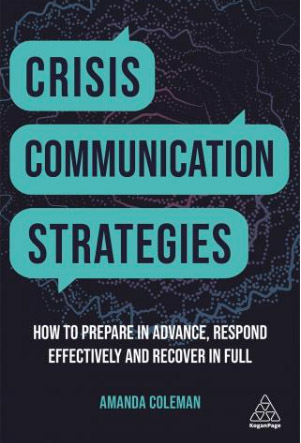Author: Amanda Coleman
ISBN No: 9781789662900
Review date: 19/04/2024
No of pages: 224
Publisher: Kogan Page
Publisher URL:
https://www.koganpage.com/product/crisis-communication-strategies-9781789662900
Year of publication: 18/05/2020
Brief:
Dealing with a crisis can be daunting; hopefully, it will never happen. So writes Amanda Coleman in Crisis Communication Strategies: sub-titled, How to Prepare in Advance, Respond Effectively and Recover in Full. It came out from the business publisher Kogan Page just as the Covid-19 virus was sweeping the world. For some – and the author as head of corporate communications for Greater Manchester Police worked through the murder of officers, sudden death of a chief constable, looting and urban riots of August 2011 and the Manchester Arena suicide bomb of May 2017 – Covid-19 is simply the latest, and an unusually long-running, crisis; which can be a workplace accident, a data breach, a flood or fire.
Amanda, and Kate Hartley, author of another, 2019 book from Kogan page on crisis comms, spoke at a webinar arranged by the publisher, featured in the July 2020 print edition of Professional Security magazine. As in the webinar, Amanda does stress and devotes one of her nine chapters to ‘recovery’. For having managed the crisis, it can be tempting to relax. As she explains, recovery is important and can be the difference between ‘suffering long-term reputational damage’ and not. She likens it, eerily, to recovery from the flu; ‘you don’t suddenly feel back to normal’.
There’s the emotional impact to consider, and through the book Amanda Coleman stresses the people – whether employees, customers or victims (and their families). Debriefing and learning are healthy for an organisation.
If you are too stingy to buy the book; or, want to get a flavour of Amanda’s writing, she blogs, as she has now become a consultant; see for example her May 2020 blog on mental health awareness week.
While you may feel that it’s too late for you to read this book or any on crisis management, Amanda may well agree: “The key to managing a crisis is to have done the preparation work and to deal with it in bite-sized chunks.” If you are a food factory, for example, what are you going to do if you have a contamination issue (whether through some fault in process, or out of malice – a blackmail threat).
If, as the author acknowledges, you are short of time or resources, at least, she says, review what needs to be in place. She offers the ‘five Ps’ to remember; people, plan, prepare, process and purpose. And ‘five key things that you need to go and do now before you forget the details’, having reached the end of the book: briefly, check that you know your organisation’s plans and that they are up to date; go over the book’s ‘key learning points and top tips’; assess risks; consider what training and support may be required; and do prepare, ‘because you never know when a crisis will be upon you’.
The author and her book are well aware of social media – if you fail to communicate with your staff (who may be caught up emotionally and physically in the crisis, besides still doing their work), any failure to do so ‘could easily be played out on social media’, by friends and family commenting. As stressed in the webinar, ‘authenticity remains essential’; crisis response is about more than a formula.
While the author is a PR person, her years at GMP mean that she is well able to articulate in terms of risk and mitigation. It may sound obvious, but a crisis may involve a business taking too long to appreciate that there is a crisis facing it, such as if it’s been hacked. She sets out in particular the military approach, and the emergency services approach (similar to the military’s), to a crisis. As she adds, other approaches are possible; in terms of legal (to leave the book for a moment, maybe helpful if there’s a data breach that should be reported to the data privacy regulator the ICO, or some compliance fault involving another industry regulator).
This book is well laid out and does not get bogged down in any jargon, and speaks to many; the leader, who is accountable; managers who will be ‘in the room’ as the crisis response unfolds; and all those affected by the crisis. For as the author sets out: “For the most seamless and effective response the organisation from top to bottom must be ready, prepared and resilient to deal with the task ahead.”
Some of the examples are more to do with security than others; some not obviously (a backlash against a brand’s advertising campaign), some to an extent (at a charity, claims of sexual exploitation by aid workers, and whistle-blowers not acted on) and some absolutely (a cyber security breach, an act of terrorism).
Thanks to her experience, Amanda Coleman speaks with authority not only of process and plan, but of feelings of those managing the crisis; remain calm, she advises, even though a crisis can come from anywhere, any time (so seldom in the middle of a weekday!).
Recommended.
Contents
Section – ONE: The lead up;
Chapter – 01: Are you ready for a crisis?;
Chapter – 02: Help recognise a crisis;
Section – TWO: During the crisis;
Chapter – 03: The operational response;
Chapter – 04: The people – Communicating internally and externally;
Chapter – 05: The leaders – The role of business leadership in a crisis;
Chapter – 06: The community – The impact on the business, the wider community and elsewhere;
Section – THREE: The aftermath;
Chapter – 07: Support – Resilience, well-being and rebuilding in both the short term and long term;
Chapter – 08: The recovery – Returning to day-to-day business;
Chapter – 09: Where next?










